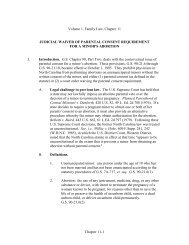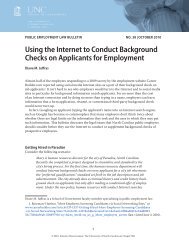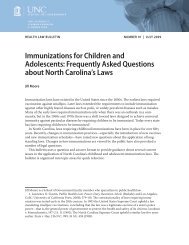Sentencing, Corrections, Prisons, and Jails - School of Government ...
Sentencing, Corrections, Prisons, and Jails - School of Government ...
Sentencing, Corrections, Prisons, and Jails - School of Government ...
Create successful ePaper yourself
Turn your PDF publications into a flip-book with our unique Google optimized e-Paper software.
228 North Carolina Legislation 1998<br />
Capital Punishment<br />
Section 17.22 <strong>of</strong> S.L. 1998-212 (S 1366) amends G.S. 15-187 <strong>and</strong> 15-188 to abolish execution by<br />
lethal gas <strong>and</strong> to establish as the only form <strong>of</strong> execution the injection <strong>of</strong> a lethal quantity <strong>of</strong> a barbiturate<br />
in combination with a chemical paralytic agent.<br />
Victim Impact Information in <strong>Sentencing</strong><br />
G.S. 15A-825(9) requires prosecutors <strong>and</strong> law enforcement agencies to make a reasonable effort to<br />
assure that every crime victim “[h]as a victim impact statement prepared for consideration by the<br />
court.” While this law does not specifically say so, “victim impact” is understood to refer to the injury<br />
<strong>and</strong> loss caused by the crime, <strong>and</strong> “consideration by the court” is understood to refer to sentencing.<br />
North Carolina’s new Crime Victims’ Rights Act, enacted by Section 19.4 <strong>of</strong> S.L. 1998-212, goes<br />
considerably further. The new law, which is discussed in more detail in Chapter 7 (Criminal Law <strong>and</strong><br />
Procedure), implements the 1996 Victims’ Rights Amendment to the N.C. Constitution. New<br />
G.S. 15A-833, which became effective December 1, 1998, <strong>and</strong> applies to <strong>of</strong>fenses committed on or after<br />
that date, gives the victim “the right to <strong>of</strong>fer admissible evidence <strong>of</strong> the impact <strong>of</strong> the crime, which shall<br />
be considered by the court or jury in sentencing the defendant.” This evidence may include the victim’s<br />
physical or psychological injury <strong>and</strong> economic or property loss. Also, the victim may submit a request<br />
for restitution <strong>and</strong> may indicate whether he or she has applied for or received compensation under the<br />
Crime Victims Compensation Act (G.S. Chapter 15B).<br />
The <strong>Sentencing</strong> Commission <strong>and</strong> Its Recidivism Studies<br />
History <strong>of</strong> the <strong>Sentencing</strong> Commission. The General Assembly created the <strong>Sentencing</strong> <strong>and</strong><br />
Policy Advisory Commission in 1990 to study sentencing <strong>and</strong> related matters <strong>and</strong> report its<br />
recommendations. The commission’s first tasks were to develop <strong>and</strong> recommend sentencing structures<br />
(that is, legislative guidelines) for judges’ use in determining the appropriate type <strong>of</strong> punishment for<br />
each case <strong>and</strong> the proper term <strong>of</strong> probation or imprisonment (if any) <strong>and</strong> to set penalty limits or ranges<br />
for criminal <strong>of</strong>fenses. The result <strong>of</strong> this initial work was draft legislation that, after considerable<br />
modification by the General Assembly, became the SSA, effective in 1994.<br />
Although the commission’s primary task <strong>of</strong> drafting new sentencing laws has been completed, it<br />
still plays an important role in the North Carolina criminal justice system. For example, G.S. 164-43(d)<br />
requires the commission to continue to<br />
monitor <strong>and</strong> review the criminal justice <strong>and</strong> corrections systems in this State to ensure that<br />
sentencing remains uniform <strong>and</strong> consistent, <strong>and</strong> that the goals <strong>and</strong> policies established by the<br />
State are being implemented by sentencing practices, <strong>and</strong> . . . recommend methods by which<br />
this ongoing work may be accomplished <strong>and</strong> by which the correctional population simulation<br />
model developed pursuant to G.S. 164-40 shall continue to be used by the State.<br />
This simulation model is intended to forecast several years into the future the effects on the correctional<br />
population (the number <strong>of</strong> persons under correctional supervision or in custody) <strong>of</strong> proposed changes in<br />
sentencing laws, or related events. The commission itself uses this model, <strong>and</strong> it must also make the<br />
model available for use by legislators <strong>and</strong> the Secretary <strong>of</strong> the N.C. Department <strong>of</strong> Correction.<br />
Forecasting the cost <strong>and</strong> the capacity implications <strong>of</strong> legislative proposals has proved to be an important<br />
tool for the General Assembly, <strong>of</strong>ten causing it to think about the future costs <strong>of</strong> various proposals to<br />
increase punishment. The forecasting model was used during the 1994 <strong>and</strong> 1995 legislative sessions to<br />
estimate the effect on the correctional system <strong>of</strong> a variety <strong>of</strong> measures under consideration.<br />
The commission has other continuing functions as well. For example, under G.S. 164-42.2 it must<br />
develop <strong>and</strong> recommend a “comprehensive community corrections strategy <strong>and</strong> organizational<br />
structure for the State.” (“Community corrections” refers to programs other than imprisonment, such as<br />
probation, community service, <strong>and</strong> restitution.) In recommending this comprehensive strategy, the<br />
commission must consider existing community-based correctional programs, new types <strong>of</strong> community













